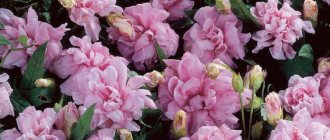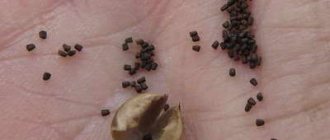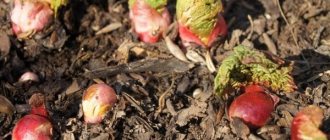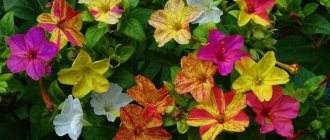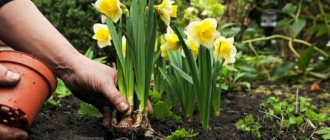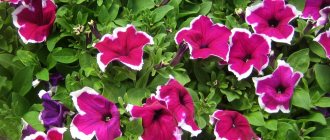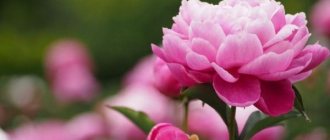Features of the survivor
Tenacious is a herbaceous semi-evergreen, evergreen or deciduous plant that can be perennial or annual. The height of the bush can vary from 0.05 to 0.5 meters. The leaf plates are located opposite. False whorls consist of flowers of blue, blue, purple or yellow color. All types of such plants are distinguished by their undemandingness to soil and growing conditions. Gardeners, as a rule, cultivate decorative foliage and ground cover species and forms of ayuga. In landscape design, it is used for growing in rock gardens, mixborders and rock gardens, and it is also cultivated as a ground cover plant.
Compatibility with other plants
Due to the unusual and non-uniform color of the leaves, it is better to plant the tenacious plant next to monochromatic plants. It should also be remembered that ayuga is classified as an aggressor plant (it easily conquers territory from small flowers), so it is better to choose plants that can “defend” their territory as neighbors. Tenacious goes well with the following plants:
- ferns;
- iris;
- rudbeckia;
- loosestrife;
- delphinium.
If you don't already have ajuga in your garden, correct this mistake immediately! As you can see, this plant brings only pleasure: with its beautiful appearance, ease of care and reproduction, and wide compatibility with other plants. By planting a tenacious plant, you will acquire the most unpretentious and one of the most beautiful inhabitants of your flower garden!
Composition, medicinal properties
Indian onion medicinal properties of a modest plant
The composition of the herbaceous perennial has not been fully studied. However, it is known that the plant is endowed with:
- iridoids;
- steroids;
- tannins;
- essential oils;
- diterpenoids;
- alkaloids;
- saccharides;
- proteins;
- saponins;
- flavonoids;
- bitter substances;
- ascorbic acid;
- vitamin K.
Thanks to its rich composition, the decorative perennial has powerful antiseptic, anti-inflammatory, diaphoretic, astringent, diuretic, wound-healing, expectorant, analgesic, hemostatic, and enveloping properties.
The use of the herb helps:
- normalization of metabolic processes;
- minimizing pain;
- elimination of inflammatory processes;
- normalizing the permeability of cells in the vascular walls, improving their elasticity;
- prevention of vascular sclerosis;
- neutralization of free radicals;
- preventing the destruction of cell membranes;
- prevention of premature aging;
- normalization of the central nervous system, emotional background;
- stimulating the function of the endocrine glands;
- stimulating skin healing;
- increasing the protective properties of the body.
Preparations based on the aerial part of the plant are effective in the fight against such pathological conditions and diseases: alopecia, wounds, ulcers, rheumatism, malaria, colds, tuberculosis, gastrointestinal diseases, stool disorders, cholelithiasis, tonsillitis, urolithiasis, gingivitis.
Creeping tenacious in landscape design video
Dogwood description of varieties, cultivation and care, medicinal properties
Tenacious creeping Geneva Helena
The Latin name of the variety is Ájuga genevensis. The bush grows up to half a meter in height. It spreads widely over the ground, but unlike many other species, it does not have shoots creeping along the ground, making it look neater in the garden. The leaves are narrow, oblong. The flowers of the plant usually have lilac shades and are arranged in whorls (from 2 to 6 flowers).
Blooms in June and July. Often in early autumn, secondary flowering of shoots is observed, which grow in width. Thanks to this, you don’t have to worry about the size of her bush – it will look pretty neat. It is also called the shaggy tenacious, because the stem is covered with a thick furry layer.
Tenacious creeping Geneva Helena
Burgundy glow
Latin name of the variety Burgundy Glow. They are about half as tall. They spread widely and produce long shoots running along the ground. They are often trimmed for decorative purposes. The flowers are collected in an elongated spike and usually have shades of blue and light blue. It is often considered by gardeners to be the most beautiful variety among the tenacious ones.
The corolla of the flower is covered with fluff on the outside, which gives additional aesthetic value to the plant. It also blooms in early summer, sometimes in May for 20-25 days. It forms a dense cover in the flowerbed, almost completely covering the ground.
Tenacious creeping Burgundy glow
Black scallop
Latin name Black Scallop. It has approximately the same height as the previous variety, and also grows in width with its creeping shoots. It has foliage with a characteristic glossy surface that reflects light well. The foliage is a deep purple hue (reminiscent of the color of beet leaves). Decorated with flowers in lilac and blue tones. This plant provides a nice contrasting color to the garden and can highlight other plants in it.
Creeping tenacious Black scallop
Chocolate chip
Latin name "Chocolate Chip". The variety received such an unusual name due to the characteristic color of the foliage (chocolate shades). The flowers are also blue and lilac tones. Flowering is observed in early summer for 3 weeks (in June). It reaches a height of 8-15 cm, but spreads well along the ground and, due to the peculiar shade of the foliage, serves as a good decoration for brighter flowers.
Creeping tenacious Chocolate chip
Purple Brocade
Latin name Purple Brocade (also sounds like ash brocade). This variety is distinguished by a beautiful shade of flowers (lilac-pink, scarlet). The flowers stretch into long narrow spikes and contrast well against the background of the bright green of the tenacious plant. This gives the effect of a small forest and decorates the garden well.
Creeping tenacious Perple brocade
Varieties
Varieties and types of tenacious differ in the most varied colors of not only flowers, but also leaves: purple, silver-green, bronze-lilac, dark brown. They also come with spots and edges of a wide variety of shades.
Today, the following species are mainly grown as garden ornamental plants.
- The creeping tenacious is the most common species among the representatives of the described genus, mainly growing in Europe. It is characterized by stems 20 cm high, creeping shoots and spike-shaped inflorescences of pink, white, blue-blue and purple colors.
- Herringbone is a low-growing annual plant with bluish-green leaves and yellow flowers that exude a fresh pine scent.
- Geneva tenacious is evergreen, up to 35 cm high. It is distinguished by the absence of creeping shoots, has leaves with large teeth and white or pink flowers.
- Pyramid tenacious is a perennial plant, approximately 20 cm high, characterized by hairy stems, rigid pyramid-shaped leaves and pink, white or lilac flowers. Among them there are quite attractive varieties with metallic-colored leaves. The plant grows very slowly and does not form a cover.
- Pseudochios tenacious has straight, pubescent stems 15 cm high, divided leaves and yellow-purple flowers.
- Laxmanna is a tall, perennial plant distinguished by unusually shaped silvery leaves and yellow or pink flowers.
- Eastern tenacious is a rare species, with white and violet-lilac flowers.
Article on the topic: Boldo - useful properties, description
Botanical characteristics
Medicinal properties of St. John's wort
Zhivuchka is a herbaceous perennial plant belonging to the genus Zhivuchka, family Lamiaceae or Lamiaceae, reaching a height of thirty centimeters or more.
The plant is endowed with straight tetrahedral stems, horizontal rhizomes that form root shoots, and pubescent oval oblong oval-ovate leaves. The basal foliage is larger, long-petioled, with spaced teeth, and the bracts are bluish and entire.
The tenacious plant is endowed with single-lipped blue or light blue flowers, collected in false whorls. The plant blooms in mid-spring. It blooms for three to four weeks. Fruit ripening occurs at the beginning of the summer period.
Meadows, thickets of bushes, forest edges, clearings are places of growth. Europe, Mediterranean, Asia, China, Iran, Afghanistan, North America, Caucasus, Ukraine - habitat.
Planting an ornamental plant
The plant is unpretentious, tolerates drought well, can grow in one place for several years, and is also very beautiful. It is for these characteristics that the flower is valued.
Planting and caring for tenacious plants in the open ground is not a difficult job. Seeds can be purchased at any specialty store. They have 100% germination rate.
Seeds should be sown immediately in open ground, at the beginning of the spring period - after the soil has warmed up, or at the end of the autumn period. The plant grows well both in sunny areas and in the shade.
Prefers to grow on cultivated garden soils and moist fertile loams. Before sowing, it is preferable to apply complex fertilizer or double superphosphate under the weeding at the rate of 10-15 kilograms per square meter.
You can also plant seedlings. It can be purchased at the store, or grown from seeds yourself. It is necessary to replant the survivor in mid-May. Don't worry about return frosts. The flower tolerates well not only drought, but also low temperatures, down to -10 degrees.
It is preferable to plant on a dry, sunny day. The optimal distance between seedlings is 30 cm. The growth point should remain above the surface of the site, the soil around the seedlings must be compacted and then watered abundantly.
Some recommendations regarding care
The tenacious plant is unpretentious in care, but if you want the flower to delight you with long-lasting abundant flowering, you still need to adhere to some rules.
Before new leaves form on the seedlings, protect them from bright sunlight, and water them often so that the soil does not have time to dry out. As soon as you see that the flowers have begun to grow, reduce watering
Moisten the soil during prolonged drought or abnormal heat. It is important to ensure that the plant does not take over more space than you have allocated for it. The flower grows quickly. To contain the survivors, fence the area with stones, slightly drowning them in the ground. In order to preserve the expressiveness of the cover, do not forget to remove the inflorescences. Cover with dry leaves for winter
The plant is not afraid of frost, but to make it survive the winter easier, it is better to insulate it.
Collection, procurement of raw materials
The above-ground part of the plant is used to make medicines. It is recommended to collect the grass during the period of intensive flowering of the tenacious plant, manually. Look at the photo how beautifully the tenacious blooms.
Next, the raw materials are sorted, rotten parts are removed, and then dried.
The grass is laid out in a thin layer on paper and dried outside in the shade. The raw materials are turned over periodically to prevent them from becoming moldy. Then the above-ground part is poured into paper bags or cardboard boxes and placed for storage in a dry room with sufficient ventilation.
Creeping survivor
About 16 species of creeping tenacious are found throughout the world, most often found in Europe and Asia. Today, scientific and traditional medicine uses only 2 types of this plant: creeping and Geneva. Most often found in thickets of bushes, as well as in swampy areas, clearings, meadows, and forest edges.
Medicinal properties
This plant has a reparative, antispasmodic, expectorant, hemostatic, choleretic, anti-inflammatory, diuretic, astringent, enveloping effect.
The plant can help with inflammation of the uterine appendages, cholelithiasis, gastrointestinal diseases, diarrhea, rheumatism, tuberculosis. Also used as an antimalarial. Normalizes metabolism. Creeping tenacious is often used to treat ulcers, sore throats, oral diseases, bruises and wounds. In case of baldness, it prevents further hair loss.
The entire plant is used as a medicinal raw material. During the period from May to August, the survivors are collected, and the stems and whorls of inflorescences must be carefully cut off. Dry the raw materials in a well-ventilated area.
Tough recipes
Preparation of a hot infusion of creeping tenacious: pour a glass of boiling water over the dry herb, then infuse and strain, then squeeze out. Take 5 times in 24 hours by spoon.
Preparation of the infusion: 2 teaspoons of crushed herb is poured into a glass of boiling water, and then infused in a closed container for 2 hours, filtered, and squeezed. Take a spoon three times a day.
Application for malaria: crushed dry herb is poured into a spoon with a glass of boiling water, then infused and filtered. Take a spoonful 5 times in 24 hours.
Preparation of plant infusion for external use: 5 tablespoons of dry raw materials are poured with a liter of boiling water, infused for 4 hours.
Using the infusion as a lotion on burns, wounds, and ulcers. For rinsing, it is used for gingivitis, sore throats, and diseases of the oral cavity.
Hair growth can be enhanced by adding an infusion of leaves and herbs when washing your hair. Crushed leaves of the plant are applied to cuts, ulcers, and purulent wounds. Freckles, shoulder bites and calluses are lubricated with the juice of fresh tenacious.
During fever, it is necessary to take tea based on this plant. This tea can replace aspirin and acts as an antipyretic.
The plant is also used for preparing salads: salt, 15 grams of vegetable oil, 50 grams of leaves and shoots, 50 grams of boiled potatoes, 1 egg.
Contraindications
The dosage must be strictly observed. If you are prone to constipation, use is strictly prohibited. The plant has a very strong choleretic effect.
Healing infusions from tenacious
To prepare a healthy decoction, you need to pour the chopped herb (8 g) with boiling water (1 glass), cool and strain thoroughly. Take the prepared solution 1 tbsp per day. spoon for stomatitis, sore throat, gingivitis. Freshly squeezed juice can be applied to bee stings, calluses and burns to alleviate the condition.
2 teaspoons of flowers and leaves of the plant are infused in 250 grams of hot water for about 1.5-2 hours, then filtered. Take 1 tablespoon of infusion before each meal for diseases of the duodenum and gastric ulcer.
Infusion of 5 tbsp. spoons of herbs (filled with one liter of boiled water), filtered after three hours. This product washes purulent wounds, moistens burns and rinses the scalp.
Action
Gokage Kaidan
During Gokage Kaidan, Hyuga Tokuma, along with Aburame Muta and Mitarashi Anko, explore one of Orochimaru's hideouts in search of Kabuto Yakushi.
Fourth Shinobi World War: Countdown
While the Jinchuriki is sent to Shimagame Island, Tokuma, along with Muta and Anko, find three corpses left behind by Kabuto and examine them, finding nothing. They don't understand why Kabuto leaves marks. Anko tells Tokuma to use the Byakugan, through which he discovers Kabuto and a masked man in the distance talking to each other before entering an underground passage.
Before Tobi declares the Fourth World War, the Ninja, Tokuma and his team are once again searching for Kabuto, and also scouting out enemy forces. Tokuma, using the Byakugan, notices that in the area of the underground passage where Kabuto and Tobi entered there are many living beings, which are the army of Shiro Zetsu. Anko tells Tokuma to leave her and report the enemy forces to headquarters, but Tokuma refuses, saying that he does not want to leave her alone in such a dangerous place, but she says that this is an order, and Tokuma is forced to leave her.
Fourth Shinobi World War: Confrontation
Omoi frees Tokuma and Ranka
When the war begins, Tokuma fights against Shiro Zetsu Tobi's army and the revived Kabuto ninja. Sasori, one of the revived, attaches chakra threads to Tokuma and Ranka, which is why they are forced to fight against their own comrades, but Omoi helps his comrades and breaks Sasori's chakra threads. He is then taken to Kiri to have his wounds healed.
Caring for survivors in the garden
Caring for ayuga is relatively simple. The bushes must be systematically watered and their uncontrolled spread must be prevented. Before young leaf plates appear on the planted plants, they need to be protected from direct rays of the sun, and the tenacious plant also needs timely watering, make sure that the soil around the bushes never dries out. After the rosettes begin to grow, the plants are practically not watered; this should be done only during extreme heat or a long dry period. Remember that such grass can grow extremely quickly, so it is necessary to constantly monitor it so that it does not spread to an area not intended for it. You can make a fence around the perimeter of the site; to do this, you need to surround the plant with stones and just press them slightly into the soil. To preserve the spectacular appearance of decorative deciduous species of ayuga, it is recommended to pluck off the inflorescences in a timely manner.
Reproduction of survivors
This herbaceous plant can be propagated by seed and vegetative methods. But it should be taken into account that it is recommended to grow ayuga from seeds only during initial planting. If you cultivate varietal plants, then remember that the seeds collected from them are not able to retain the characteristics of the mother plant. In this regard, they are propagated by rosettes. Vegetative propagation of the tenacious species occurs in early spring or autumn (until the second ten days of September). The bushes should be trimmed with overgrown rosettes, which are transplanted to a new location one at a time or several at a time. It happens that the outlet has only 1 thin root, despite this, it is able to quite successfully take root in a new place. If the separation of rosettes is carried out once a year, then when planting between the bushes, a distance of 15 centimeters should be maintained. If this procedure is carried out once every 2 years, then at least 0.25 m should be left between the plants. After the rosettes take root and begin to grow, they stop watering them.
Ayuga can also reproduce by self-sowing, but the young plants that have grown will not be able to retain the varietal characteristics of the mother bush. To prevent self-seeding, flower stalks should be cut off in a timely manner. So, for deciduous species this should be done when the arrow just begins to grow, and for flowering species - when they fade. This activity is quite labor-intensive, but basic care for the survivor is very simple.
Diseases and pests
Ayuga is highly resistant to diseases and pests. However, such a plant can be disturbed by slugs, which eat its tender leaves at night. As a rule, slugs become active at high humidity and low air temperatures. However, for such gastropods, a strip of crushed stone or gravel will be an almost insurmountable obstacle; such a “fence” is made around the area with the survivor.
Diseases and pests
The tenacious plant can be affected by many dangerous diseases and pests that can destroy a flower overnight.
Fungal rot
It occurs when the humidity of the earth and air is too high. Because of the fungus, the plant and its roots begin to rot. The flower stops developing, does not bloom and does not produce children. Yellowing and falling of leaves occurs. Due to root rot, a gray coating and brown spots appear on the roots. What to do to combat this disease:
- diseased parts are removed using a sharp instrument. Charcoal is poured onto the cut areas;
- healthy parts and other plants are treated with fungicides.
What does fungal rot look like?
Snails and slugs
These are the only pests that spoil ayuga. Insects do not attack it, as it has a unique composition. The leaves contain a substance that prevents the development of larvae. The appearance of slugs and snails is associated with excessive humidity. As a means of control, special chemicals are used, which can be purchased at any gardening store. Crushed hot pepper is used as a folk remedy. A mustard solution is also used, which is sprayed on the plant. To prevent pests from moving around the area, crushed eggshells are used. It is sprinkled on leaf plates.
Snail is a pest of ayuga
The tenacious plant is an unpretentious flower. It can grow anywhere: in the shade or in the sun. However, if there is excessive humidity, slugs and diseases can appear on it. In this case, the flower must be saved, otherwise it may die in a matter of days.
Options for using creeping and pyramidal tenacious in garden decor
There are many options for using this plant to decorate the garden. The fact is that the tenacious plant has a variety of shapes, covers the ground well, creates a contrasting background that favorably emphasizes other flowers.
Moreover, the plant can be used not only as an independent design tool, but also in combination with many other flowers and garden greens:
- Pyramid tenacious has flowers of dark purple, blackberry shades; they are located on elongated narrow ears, which creates a good effect of rising in height. They can be used to frame different sectors of the garden, planted along the perimeter (this creates a beautiful flower border that highlights the contours of the area), as well as according to a pre-made pattern - for example, waves and zigzags.
- You can create small flower beds from tenacious flowers, alternating them with taller flowers in order to favorably emphasize both. The effect of contrast will be manifested due to differences in heights, as well as due to the dark shades of the flowers of the pyramidal tenacious plant (or the green part of the Black scallop plant).
- It is very beautiful to frame flower beds made of tenacious flowers with decorative roots in white shades. This looks especially appropriate when creating a flower garden in the style of a rock garden - it creates the effect of snow-capped peaks on which flowers grow (for this you can plant plants on hills or hills).
- A very successful decoration option is to plant the survivor on the shore of a country pond under taller plants. This creates the effect of a coastal forest with beautiful flowers along the pond.
- Ayuga can be grown next to coniferous plants - together the composition will create the effect of movement and upward direction.
- Also, the tenacious plant looks harmonious with ferns, which contrast with it in the shades of the leaves and at the same time are located on approximately the same tier.
- An excellent combination is created by tenacious with iris, the bright flowers of which look good against the backdrop of solid green carpets of ayuga.
- Finally, the most universal option is to plant the plant in all unused areas that look unsightly due to the blackening soil. The tenacious will cover all open spaces well and create an original green carpet effect.
Use in folk medicine
Tenacious is a useful plant. There are many recipes for decoctions, infusions, and herbal teas. The drugs will help in the treatment of various ailments, the main thing is to prepare and take them correctly. Try to adhere to the recommended proportions and do not overuse the ingredients.
Before using a particular product, consult your doctor regarding its appropriateness in a particular case. Do not refuse drug therapy for the disease. Remember, an integrated approach to treatment is the key to a speedy recovery.
- In the fight against malaria, rheumatism, colds, diarrhea, cholelithiasis, it is useful to take the infusion. Steam 20 g of dried crushed herb in a glass of boiling water. Place the mixture in a warm place for three hours. Take 20 ml of filtered medicine three times a day.
This remedy is also suitable for external use on burns, ulcers, and wounds. It is used as baths, lotions, and is also used to rinse the oropharynx for tonsillitis.
- For the treatment of stomach ulcers, sore throat, bronchitis, cough, tracheitis, it is recommended to use a decoction. Brew 10 g of the above-ground part of the plant in three hundred milliliters of boiling water. After boiling, simmer over low heat for ten minutes. It is recommended to take 30 ml of the drug four times a day.
The same decoction can be used externally for the treatment of stomatitis, gum disease, and tonsillitis.
- It is useful for people suffering from pathologies of the genitourinary system and liver to take the tincture. Fill a tablespoon of the dry aerial part with medical alcohol - half a glass. Place the tightly closed container in a cool place for half a month. Take a teaspoon of strained medicine three times a day.
You can make an anti-acne lotion based on the tincture. Mix 100 ml of the drug with boiled, cooled water - 300 ml. Soak a cotton swab in the lotion, and then treat problem areas.
- Tea can be used as an antipyretic medicine. Mix tenacious grass with lemon balm and linden blossom in equal proportions. Steam 20 g of the mixture with boiling water. Drink a cup of the drink three times a day instead of tea.
- In the fight against bee stings, burns, candidiasis in children, calluses, you can use the juice of the plant. Freshly squeezed juice is applied to the affected areas of the body.
- For the treatment of chronic enterocolitis accompanied by diarrhea, it is recommended to use an infusion. Mix tenacious grass with centaury, warthog, rue, woodruff, plantain, mullein, and alder in equal proportions. Steam a tablespoon of the mixture in 400 ml of boiling water. Let the product brew. After three hours, filter. Drink half a glass three times a day. The duration of the therapeutic course is two months.
- This collection is suitable for the treatment of uterine bleeding. Combine equal proportions of tenacious with nettle, lavender, jasmine, burdock, mantle, wintergreen, blueberry leaves, barberry bark, and steelberry rhizome. Steam 30 g of raw materials with boiling water - 500 ml. Boil the mixture over low heat for a quarter of an hour. Drink ½ cup of strained medicine three times a day.
Contraindications
The plant has few contraindications for use. It is not recommended to use the decorative perennial for medicinal purposes for women during pregnancy, breastfeeding, people with individual intolerance, and a tendency to constipation.
The herb will bring exceptional benefits to the body. The main thing is to take medications correctly and not exceed dosages. Before using tenacious for therapeutic purposes, do not forget to consult your doctor.
Popular types of resilient beauty
Perennial ground cover flowers are tenacious and can survive in extreme conditions. They are not afraid of summer heat, cold winter, humid or dry climate. The plant grows well on slopes, among stones and near borders. Decorates the base of trees and shrubs in the garden area. Fits perfectly into the interior as an hanging plant. In gardening, there are more than 50 species of resilient beauty.
Geneva's tenacious
This species is found in the black earth zone of Russia. It can be seen on the steep slopes of the Caucasian and Crimean mountains. In European forests and Scandinavia. In Asia Minor and the Mediterranean countries.
The tenacious Geneva Helena is a cluster-rooted perennial plant. It has horizontal roots, from which shaggy-hairy shoots extend. On average, the stems grow up to 40 cm. Short petiolate leaves grow at the base, and on the shoot they are sessile, oblong in shape with a jagged edge.
The flowers are in whorls of 2 to 6 pieces. Their upper part forms a spike. The calyx of the bud reaches 7 mm. The structure is hairy. Color – bluish, occasionally white. Flowering occurs in May or July.
The fruits of the plant appear in the form of brown nuts with a wrinkled surface. Propagated vegetatively or by seeds.
Pyramidal survivor
This particular species is found in the alpine meadows of Europe. It is a perennial plant. Grows from 15 cm in height to 30.
The pyramidal tenacious has a huge number of shoots, which are characterized by:
- tetrahedral shape;
- upright position;
- shaggy covering.
Numerous leaves at the base grow up to 11 cm. The shape resembles an ellipse, narrowed into a petiole. Those that grow near the inflorescence are ovoid in shape. The edges are slightly jagged. Color – dark green.
The buds are blue or pale purple, located along the stem. Reminiscent of the original flower spike.
Tenacious atropurpurea
The leaves of this perennial are dark with a red or brownish tint. Grows 15 cm in height. The peculiarity of the tenacious variety Atropurpurea is that it does not have creeping stems.
The result is always a compact appearance on garden lawns. Loves a lot of light. Easily tolerates cold. Used in gardens with rocky soil.
Glamorous variety - mahogany
The tenacious mahogany grows up to 10 or 15 cm. It has round, glossy leaves of a reddish color.
There are also specimens with a dark burgundy tint. It blooms with blue buds located along an erect shoot. Loves moving shadows, but is not afraid of direct sunlight.
Various varieties of tenacious are widely used in summer cottages. An incredibly beautiful living carpet, woven from graceful flower spikes, will replace a grass lawn.
In the landscape design of slopes, the tenacious plant harmoniously combines with other plants. In the flowerbed, ayuga is an original background for noble flowers, which pleases the eye throughout the warm season.
Description of the plant, its known varieties and varieties
High ability to survive is the main quality of the tenacious plant, or ajuga, as its botanical plant sounds in Latin. In nature, the ground cover grows in forests and meadows of warm climate zones. General description of the plant:
- Perennial with creeping, long stems capable of rooting.
- The height of the survivors is 10-50 cm.
The survivor fully lives up to its name and adapts well
- The wavy leaves have either a short petiole or no petiole at all. Their shape is mainly ovoid.
- The inflorescences are spike-shaped, consisting of 6-8 blue or dark blue flowers, the upper lip of which is very short, two-lobed.
Attention! The plant is a tenacious plant that tends to quickly spread and suppress nearby crops. Therefore, its planting must be carefully planned.
Ayuga, care and cultivation
I advise growing ayuga among garden flowers for those who do not really like to deal with capricious plants. It does not need to be replanted often - the decorative appearance of ayuga will delight you for several years. Moreover, the flower does not need frequent watering, which makes it simply an ideal plant among garden flowers.
Watering ayuga
You can leave the survivor without water for about three weeks, or even for a month in not very hot weather. True, by the end of the proposed period the flower may fade slightly, but will recover perfectly with abundant “soldering.”
But pay attention - a young plant still needs to be watered more often, at least until the root system takes root. If, after frost, a perennial ayuga emerges slightly frostbitten, do not be discouraged - a little time will pass and the plant will shine with pure colors
Soil for ayuga
As for the growing soil, tenacious can be planted in almost any soil. You can create a flower bed for ajuga where you would not do it for sensitive garden flowers. I tried to plant ajuga in places where it is almost always damp and in areas scorched by the sun - the tenacious plant feels equally good in any conditions. Moreover, you should not worry about ayuga in case of fairly strong, but short-term frosts - the plant will withstand even ten degrees of frost.
But, nevertheless, I would recommend that gardeners pay a little attention to this unpretentious plant in early spring. A little regular fertilizer for garden flowers, and ayuga will steadily withstand all the vagaries of the weather. Also, do not neglect to water abundantly in dry weather, and the bright colors of the tenacious will remain in sight even after the grass around it dries out.
Neither wet soil nor sharp cold can harm the ayuga. However, in cool weather, an unkempt plant can become a tasty morsel for slugs. To avoid the appearance of snails, I carefully clean the areas where the snails grow from debris - leaves and stones. But if the slug attack is quite impressive, then I advise you to spread a little superphosphate on polyethylene near the plant.
Reproduction
Tenacious can be propagated in different ways.
Seeds
Breeding in this way is not the best option; it is only suitable for those who are just starting to live and do not have adult bushes to obtain rosettes. If there are such plants, and you still decide to take ripe seeds from them, be prepared for an unexpected result. The ayugas obtained from them are unlikely to correspond to the description of the variety.
Vegetatively
Breeding in this way should be left until March or the first quarter of September. The rosettes that have managed to appear on the mother plant are cut off and planted in the place where they will grow permanently. You can get a lot of new bushes, because it doesn’t matter whether the cuttings have thick roots, you can also take those with one root.

